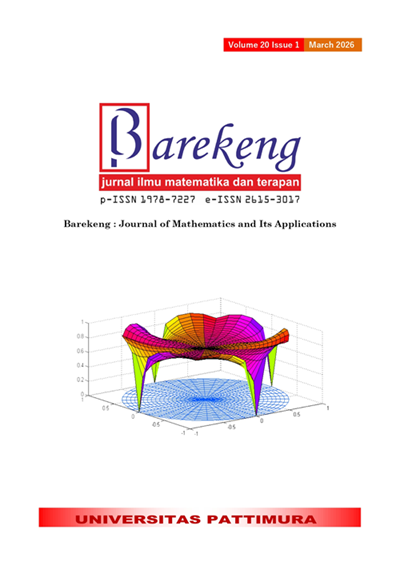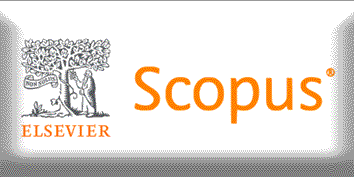A NOVEL PUBLIC-KEY CRYPTOGRAPHY SCHEME UTILIZING SKEW CIRCULANT MATRICES WITH GENERALIZED ALTERNATING FIBONACCI
Abstract
Circulant and skew circulant matrices play a significant role in various applications, especially in cryptography. Their determinants and inverses can be used in the decryption process. In classical cryptography, the Hill cipher is known to be susceptible to known-plaintext attacks and requires matrix-based key transmission. This study introduces a new public-key cryptography scheme that combines the Hill cipher with the ElGamal technique, utilizing skew circulant matrices with generalized alternating Fibonacci numbers. These numbers provide a pattern that simplifies the explicit formulas of the determinant and inverse of the matrices. The proposed scheme is the first of its kind to use these matrices and numbers for public-key cryptography. Explicit formulas for the determinant and inverse of these matrices are derived using elementary row and column operations. The proposed scheme is resistant to the discrete logarithm problem, known-plaintext, and brute-force attacks and requires only the transmission of key parameters. The implementation of the scheme has been tested using Wolfram Mathematica. In practice, the computational time of the scheme is significantly faster than three other related schemes, with up to 500 times faster in encryption and 17 times faster in decryption.
Downloads
References
P. J. Davis, CIRCULANT MATRICES. New York: John Wiley & Sons, 1979.
U. R. Bodasingi and S. Gunupuru, “NEW DIGITAL SIGNATURE SCHEME BASED ON RSA USING CIRCULANT MATRIX,” SN Comput Sci, vol. 4, no. 3, p. 275, 2023. doi: https://doi.org/10.1007/s42979-023-01694-4.
M. Sever, “A NTRU TYPE CRYPTOSYSTEM BASED ON CIRCULANT MATRICES,” Turkish Journal of Science, vol. 9, no. 3, pp. 207–215, 2024.
A. Pandey, I. Gupta, and D. Kumar Singh, “IMPROVED CRYPTANALYSIS OF A ELGAMAL CRYPTOSYSTEM BASED ON MATRICES OVER GROUP RINGS,” Journal of Mathematical Cryptology, vol. 15, no. 1, pp. 266–279, 2020. doi: https://doi.org/10.1515/jmc-2019-0054.
B. Amutha and R. Perumal, “PUBLIC KEY EXCHANGE PROTOCOLS BASED ON TROPICAL LOWER CIRCULANT AND ANTI CIRCULANT MATRICES,” AIMS Mathematics, vol. 8, no. 7, pp. 17307–17334, 2023. doi: https://doi.org/10.3934/math.2023885.
Maxrizal, I. G. N. Y. Hartawan, P. Jana, and B. Desy Aniska Prayanti, “MODIFIED PUBLIC KEY CRYPTOSYSTEM BASED ON CIRCULANT MATRIX,” J Phys Conf Ser, vol. 1503, no. 1, p. 12007, 2020. doi: https://doi.org/10.1088/1742-6596/1503/1/012007.
X. Zhang, X. Jiang, Z. Jiang, and H. Byun, “ALGORITHMS FOR SOLVING A CLASS OF REAL QUASI-SYMMETRIC TOEPLITZ LINEAR SYSTEMS AND ITS APPLICATIONS,” Electronic Research Archive, vol. 31, no. 4, pp. 1966–1981, 2023. doi: https://doi.org/10.3934/era.2023101.
S. UÇAR and N. YILMAZ ÖZGÜR, “RIGHT CIRCULANT MATRICES WITH GENERALIZED FIBONACCI AND LUCAS POLYNOMIALS AND CODING THEORY,” Balıkesir Üniversitesi Fen Bilimleri Enstitüsü Dergisi, vol. 21, no. 1, pp. 306–322, 2019. doi: https://doi.org/10.25092/baunfbed.547188.
G. G. Garayar-Leyva, H. Osman, J. J. Estrada-López, and O. Moreira-Tamayo, “SKEW-CIRCULANT-MATRIX-BASED HARMONIC-CANCELING SYNTHESIZER FOR BIST APPLICATIONS,” Sensors, vol. 22, no. 8, p. 2884, 2022. doi: https://doi.org/10.3390/s22082884.
K.-Y. Lu, “DIAGONAL AND CIRCULANT OR SKEW-CIRCULANT SPLITTING PRECONDITIONERS FOR SPATIAL FRACTIONAL DIFFUSION EQUATIONS,” Computational and Applied Mathematics, vol. 37, no. 4, pp. 4196–4218, Sep. 2018. doi: https://doi.org/10.1007/s40314-017-0570-6.
M.-Z. Zhu, Y.-E. Qi, and G.-F. Zhang, “ON CIRCULANT AND SKEW-CIRCULANT PRECONDITIONED KRYLOV METHODS FOR STEADY-STATE RIESZ SPATIAL FRACTIONAL DIFFUSION EQUATIONS,” Linear and Multilinear Algebra, vol. 69, no. 4, pp. 719–731, Mar. 2021. doi: https://doi.org/10.1080/03081087.2019.1617230.
Z. Liu, X. Qin, N. Wu, and Y. Zhang, “THE SHIFTED CLASSICAL CIRCULANT AND SKEW CIRCULANT SPLITTING ITERATIVE METHODS FOR TOEPLITZ MATRICES,” Canadian Mathematical Bulletin, vol. 60, no. 4, pp. 807–815, Dec. 2017. doi: https://doi.org/10.4153/CMB-2016-077-5.
Z. Liu, F. Zhang, C. Ferreira, and Y. Zhang, “ON CIRCULANT AND SKEW-CIRCULANT SPLITTING ALGORITHMS FOR (CONTINUOUS) SYLVESTER EQUATIONS,” Computers & Mathematics with Applications, vol. 109, pp. 30–43, Mar. 2022. doi: https://doi.org/10.1016/j.camwa.2022.01.027.
I. Dokuzova and D. Razpopov, “FOUR-DIMENSIONAL ALMOST EINSTEIN MANIFOLDS WITH SKEW-CIRCULANT STUCTURES,” Journal of Geometry, vol. 111, no. 1, p. 9, Apr. 2020. doi: https://doi.org/10.1007/s00022-020-0521-z.
Y. Wei, Y. Zheng, and Z. Jiang, “SKEW-CIRCULANT MATRIX AND CRITICAL POINTS OF POLYNOMIALS,” Journal of Mathematical Inequalities, no. 4, pp. 1427–1431, 2023. doi: https://doi.org/10.7153/jmi-2023-17-93 https://doi.org/10.7153/jmi-2023-17-93.
A. Menezes, P. C. van Oorschot, and S. A. Vanstone, HANDBOOK OF APPLIED CRYPTOGRAPHY. Florida: CRC Press, 1996.
M. K. Viswanath and M. R. Kumar, “A PUBLIC KEY CRYPTOSYSTEM USING HIIL’S CIPHER,” Journal of Discrete Mathematical Sciences and Cryptography, vol. 18, no. 1–2, pp. 129–138, 2015. doi: https://doi.org/10.1080/09720529.2014.962856.
P. Sundarayya and G. Vara Prasad, “A PUBLIC KEY CRYPTOSYSTEM USING AFFINE HILL CIPHER UNDER MODULATION OF PRIME NUMBER,” Journal of Information and Optimization Sciences, vol. 40, no. 4, pp. 919–930, 2019. doi: https://doi.org/10.1080/02522667.2018.1470751.
R. K. Hasoun, S. Faris Khlebus, and H. K. Tayyeh, “A NEW APPROACH OF CLASSICAL HILL CIPHER IN PUBLIC KEY CRYPTOGRAPHY,” International Journal of Nonlinear Analysis and Applications, vol. 12, no. 2, pp. 1071–1082, 2021. doi: https://doi.org/10.22075/ijnaa.2021.5176.
Z. Y. Karatas, E. Luy, and B. Gonen, “PUBLIC KEY CRYPTOSYSTEM BASED ON MATRICES,” Int J Comput Appl, vol. 182, no. 42, pp. 47–50, Feb. 2019. doi: https://doi.org/10.5120/ijca2019918432.
A. V. N. Krishna, A. H. Narayana, and M. K. Vani, “A NOVEL APPROACH WITH MATRIX BASED PUBLIC KEY CRYPTO SYSTEMS,” Journal of Discrete Mathematical Sciences and Cryptography, vol. 20, no. 2, pp. 407–412, Feb. 2017. doi: https://doi.org/10.1080/09720529.2015.1085738.
M. Kumari and J. Tanti, “CRYPTOGRAPHY USING MULTINACCI BLOCK MATRICES,” International Journal of Nonlinear Analysis and Applications, vol. 14, no. 10, pp. 57–65, 2023. doi: 10.22075/ijnaa.2023.29918.4295.
J. Panchal, H. Chandra, and A. Singh, “A NEW PUBLIC KEY CRYPTOGRAPHY USING GENERALIZED FIBONACCI MATRICES,” Surveys in Mathematics and its Applications, vol. 19, pp. 301–316, 2024.
K. Prasad and H. Mahato, “CRYPTOGRAPHY USING GENERALIZED FIBONACCI MATRICES WITH AFFINE-HILL CIPHER,” Journal of Discrete Mathematical Sciences and Cryptography, vol. 25, no. 8, pp. 2341–2352, 2021. doi: https://doi.org/10.1080/09720529.2020.1838744.
A. R. Naseri, A. Abbasi, and R. E. Atani, “A NEW PUBLIC KEY CRYPTOGRAPHY USING M_Q MATRIX,” Journal of Mathematical Modeling, vol. 11, no. 4, 2023.
K. Prasad, M. Kumari, and H. Mahato, “A MODIFIED PUBLIC KEY CRYPTOGRAPHY BASED ON GENERALIZED LUCAS MATRICES,” Communications in Combinatorics and Optimization, vol. 10, no. 3, pp. 665–679, 2025.
V. Billore and N. Patel, “CRYPTOGRAPHY UTILIZING THE AFFINE-HILL CIPHER AND EXTENDED GENERALIZED FIBONACCI MATRICES,” Electron J Math Anal Appl, vol. 11, no. 2, pp. 1–11, 2023. doi: https://doi.org/10.21608/ejmaa.2023.295792.
R. E. Cline, R. J. Plemmons, and G. Worm, “GENERALIZED INVERSES OF CERTAIN TOEPLITZ MATRICES,” Linear Algebra Appl, vol. 8, no. 1, pp. 25–33, 1974. doi: https://doi.org/10.1016/0024-3795(74)90004-4.
S. Guritman, “SIMPLE FORMULATIONS ON CIRCULANT MATRICES WITH ALTERNATING FIBONACCI,” Communications of the Korean Mathematical Society, vol. 38, no. 2, pp. 341–354, 2023.
F. YEŞİL BARAN, “THE EIGENVALUES OF CIRCULANT MATRICES WITH GENERALIZED TETRANACCI NUMBERS,” Gümüşhane Üniversitesi Fen Bilimleri Enstitüsü Dergisi, vol. 11, no. 2, pp. 417–423, 2021. doi: https://doi.org/10.17714/gumusfenbil.830575.
Y. Gong, Z. Jiang, and Y. Gao, “ON JACOBSTHAL AND JACOBSTHAL-LUCAS CIRCULANT TYPE MATRICES,” Abstract and Applied Analysis, vol. 2015, pp. 1–11, 2015. doi: https://doi.org/10.1155/2015/418293.
Y. Wei, Y. Zheng, Z. Jiang, and S. Shon, “DETERMINANTS, INVERSES, NORMS, AND SPREADS OF SKEW CIRCULANT MATRICES INVOLVING THE PRODUCT OF FIBONACCI AND LUCAS NUMBERS,” Journal of Mathematics and Computer Science, vol. 20, no. 1, pp. 64–78, 2019. doi: https://doi.org/10.22436/jmcs.020.01.08.
J. Yao and J. Sun, “EXPLICIT DETERMINANTS AND INVERSES OF SKEW CIRCULANT AND SKEW LEFT CIRCULANT MATRICES WITH THE PELL-LUCAS NUMBERS,” Journal of Advances in Mathematics and Computer Science, vol. 26, no. 2, pp. 1–16, 2018. doi: https://doi.org/10.9734/JAMCS/2018/38768.
Z. Jiang and Y. Wei, “SKEW CIRCULANT TYPE MATRICES INVOLVING THE SUM OF FIBONACCI AND LUCAS NUMBERS,” Abstract and Applied Analysis, vol. 2015, pp. 1–9, 2015. doi: https://doi.org/10.1155/2015/951340.
Y. Zheng and S. Shon, “EXACT DETERMINANTS AND INVERSES OF GENERALIZED LUCAS SKEW CIRCULANT TYPE MATRICES,” Appl Math Comput, vol. 270, pp. 105–113, Nov. 2015. doi: https://doi.org/10.1016/j.amc.2015.08.02.
P. Lancaster and M. Tismenetsky, THE THEORY OF MATRICES WITH APPLICATIONS, 2nd ed. San Diego: Academic Press, 1985.
T. S. Fun and A. Samsudin, “AN EFFICIENT ELGAMAL ENCRYPTION SCHEME BASED ON POLYNOMIAL MODULAR ARITHMETIC IN F_2^n,” in ICCST 2017, R. Alfred, H. Lida, A. Ibrahim, and Y. Lim, Eds., Singapore: Springer, 2018, pp. 99–107. doi: https://doi.org/10.1007/978-981-10-8276-4_10.
N. Jacobson, BASIC ALGEBRA I, 2nd ed. New York: Dover Publications, Inc, 2009.
Copyright (c) 2025 Sapto Mukti Handoyo, Sugi Guritman, Jaharuddin Jaharuddin

This work is licensed under a Creative Commons Attribution-ShareAlike 4.0 International License.
Authors who publish with this Journal agree to the following terms:
- Author retain copyright and grant the journal right of first publication with the work simultaneously licensed under a creative commons attribution license that allow others to share the work within an acknowledgement of the work’s authorship and initial publication of this journal.
- Authors are able to enter into separate, additional contractual arrangement for the non-exclusive distribution of the journal’s published version of the work (e.g. acknowledgement of its initial publication in this journal).
- Authors are permitted and encouraged to post their work online (e.g. in institutional repositories or on their websites) prior to and during the submission process, as it can lead to productive exchanges, as well as earlier and greater citation of published works.






1.gif)



